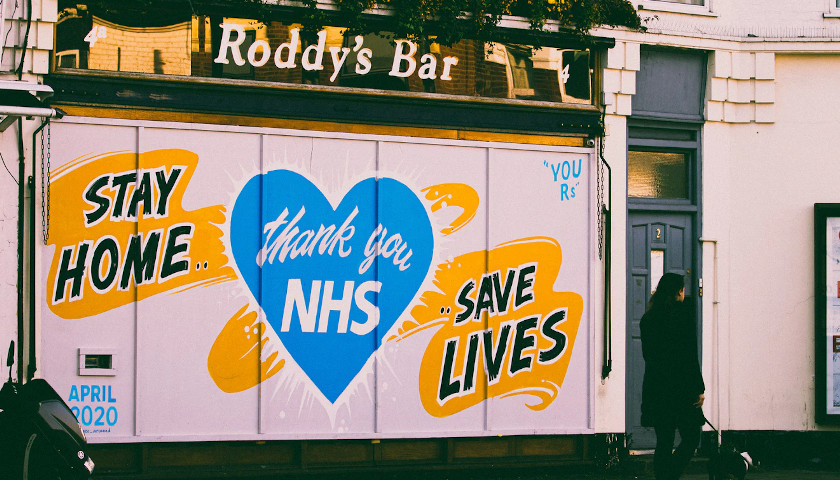by Bethany Blankley
Two emergency room doctors in California argue the data about the novel coronavirus does not warrant a stay-at-home order. A new report gives evidence that “lockdowns don’t work.” Still others argue that quarantining the sick, not the healthy, is the best course of action.
Stay-at-home orders, low assembly thresholds and business closures together constitute a lockdown, Lymon Stone argues in a column published by Public Discourse, a journal of the Witherspoon Institute, which he says don’t work. Stone cites examples of failed lockdowns in West Africa, China, Italy and Spain.
“It was centralized quarantine that beat COVID in Wuhan,” China, he notes, “not lockdowns.”
“Many policies provide public-health benefits in pandemics, such as making facemasks mandatory, cancelling school, and banning large assemblies and long-distance travel,” Stone wrote. “But ordering people to cower in their homes, harassing people for having play dates in the park, and ordering small businesses to close regardless of their hygienic procedures has no demonstrated effectiveness.”
State Sen. Donna Campbell, a board certified emergency room physician in New Braunfels, Texas, said at a recent Texas Public Policy Foundation panel that historically, quarantines are not for the healthy, but for the sick. Keeping healthy people indoors raises concerns about potentially weakening healthy immune systems. People need to be outside, exercising, and following general hygiene practices that they should follow all of the time even when there is no pandemic.
“We absolutely believe more people have contracted the disease who have not been tested which means the death rate is far lower than projected, which is a good thing,” Campbell said.
Texas has a coronavirus infection rate of .00008 percent and holds the third-highest rate of recovery from the virus in the nation. Texas Gov. Greg Abbott announced the state would reopen with restrictions May 1.
“Centralized quarantine orders, where individuals who test positive or individuals who have had contact with COVID-infected people are forced to be quarantined for seven, fourteen, or twenty-one days in hotels or special-purpose spaces are an extremely effective way to fight disease,” Stone said.
Cato Institute’s Alex Nowrasteh argues that mass quarantines can backfire.
“It’s difficult to know who is sick and who is not, so quarantines end up locking many sick people in with many healthy people,” he writes. “Healthy people and those who think they are healthy understand accurately that they would reduce their chance of becoming ill if they emigrate. By doing that, some people transmit the disease. Under some scenarios, the stricter the quarantine, the more people invest in emigrating. Sometimes, this behavioral response results in wider transmission of the disease.”
In a 51 minute interview with 23 ABC News, Dr. Dan Erickson and Dr. Martin Massihi, of Accelerated Health Care in Bakersfield, California, talked about the impact of the coronavirus on Kern County, arguing that the ongoing stay-at-home orders are not based on data or science.
As the data has come in, which Erickson says he’s collected since December, he asked, “We’ve never ever responded like this in the history of the country, why are we doing this now?”
He said people are worrying too much about the virus because the media is telling them to.
“I’m telling them that sheltering in place decreases your immune system and as we all come out of shelter in place, with a lower immune system and start trading viruses and bacteria, what do you think is going to happen? Disease is going to spike,” he said. “And then you’ve got disease spike amongst a hospital system with furloughed doctors and nurses. This is not the combination we want to set up for a healthy society.”
Of the total patients Accelerated Health Care tested for the coronavirus, 6.5 percent tested positive for the virus. Statewide, the number is 12 percent positive. Of 39 million people in the state, that equates to roughly 4.7 million people testing positive for the coronavirus. The good news, Erickson says, it is widespread, and the death rates aren’t. The chance of dying from the coronavirus is 0.03 percent in California, he says based on the raw data.
“The initial models were woefully inaccurate,” Erickson said. “They predicted millions of cases of death, not of prevalence or incidents, but death. That is not materializing.”
Some of the models, he says, were based on social distancing but even those predicted hundreds of thousands of deaths, which has not happened. Slightly more than 1,200 people have died from the virus in California.
Based on the death rates influenza A and B, he says the death rates are not worse for coronavirus. Of the 45 million cases of the flu in 2017, there were 62,000 deaths, or 0.13 percent. The swine and bird flus were more deadly and neither constituted shutting down the economy.
The question Erickson asks is whether the coronavirus’ 0.03 percent death rate necessitates the shelter-in-place order, shutting down the state’s medical systems, and putting a record number of Californians out of work.
– – –
Bethany Blankley is a contributor to The Center Square.




